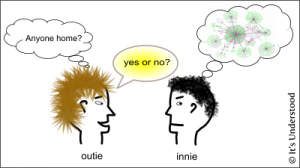 Have you ever encountered a group meeting; brainstorming, retrospective or other variety that was simply dominated by an outspoken minority? This often happens despite the best intentions and efforts of the meeting chairperson or facilitator. The result can be a fairly predictable set of proposals that rarely stretch any boundaries. In his book “Think Better” Tim Thurson calls this unfortunate result “braindrizzle”.
Have you ever encountered a group meeting; brainstorming, retrospective or other variety that was simply dominated by an outspoken minority? This often happens despite the best intentions and efforts of the meeting chairperson or facilitator. The result can be a fairly predictable set of proposals that rarely stretch any boundaries. In his book “Think Better” Tim Thurson calls this unfortunate result “braindrizzle”.
The likelihood of this dilemma is higher self-organizing teams where a facilitator role is absent. And the risk of skewed participation in a mixed group of introverts and extroverts in this case is even greater. Recently, project management consultant Johanna Rothman said, “It only takes one extrovert to kill a team of introverts.” How then to ensure the best thoughts of all team members are aired?
Not everyone is comfortable with the open outcry methods of traditional brainstorming techniques – least of all, those of us who prefer some time for reflection. “Brainwriting” – the silent cousin to “brainstorming” – is an important and useful technique that gives everyone equal opportunity to contribute their thoughts. It overcomes the “social disadvantage” on the part of introverts by ensuring the loudest (or most glib) voices don’t prevail in a group discussion. The added time to reflect on suggestions is a boon to introverts without stifling extroverted inclinations to be heard. We can easily adopt this process without cost or strain.
Developed by Horst Geschka and his associates at the Batelle Institute in Germany, Brainwriting is cited in two recent collections of collaboration techniques designed to prompt creative thinking: Michael Michalko’s “Thinkertoys – a handbook of creative-thinking techniques” and, more recently, “Gamestorming“, by Dave Gray, Sunni Brown and James Macanufo. Both these thought-provoking books are filled with useful ideas for creating new ideas in a wide variety of circumstance.
“The best way to get good ideas is to get lots of ideas, and throw the bad ones away.” – Linus Pauling
How does it work?
Rather than engaging in public outcry of ideas in a forum participants are asked to write their ideas on cards (or sticky notes) and pass them along to the person on their right. In turn, each person is asked to write down any new ideas stimulated by the cards they receive and pass them along.
This process has four key benefits:
- Participation increases because people not inclined to speak up in group settings don’t feel at a disadvantage and are likely to contribute more readily and fully.
- The rate of idea generation is fostered by separating idea creation from its criticism. Both thought processes are essential for generating useful suggestions but differ. Tim Thurson describes them as divergent (creative) thinking versus convergent (critical) thinking. The generation of productive ideas occurs best when these are separated in time.
- Thirdly, more ideas can be created because several ideas are rotating around the group in parallel and the temptation to interrupt idea generation by debating the merits of an idea instantly is avoided. ideas are built upon and creative alternatives are more likely to emerge.
- The quality of ideas can improve by the inherent opportunity to build upon one anothers’ proposals.
When completed, the cards (or sticky notes) can be compiled by posting them on a wall where they can be grouped and rated by participant voting. This process allows the group to quickly identify the ideas most worth pursuing. These can then be explored in more detail, assigned for research or other action and used to drive real innovation.
